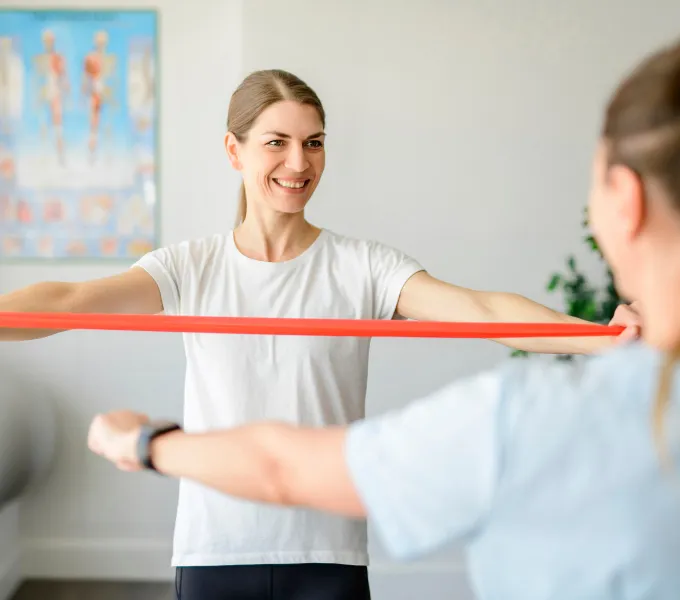
The Research Behind Hypopressives
The Abdominal Hypopressive Technique (AHT) was developed in the 1980s in Belgium by Marcel Caufriez as an alternative to traditional pelvic floor muscle training (commonly known as Kegels). He proposed that the technique would decrease intra-abdominal pressure and activate the pelvic floor muscles and abdominals.
In physical therapy, as in all other parts of the health and wellness community, trends come and go as practitioners and patients look to find the newest and most effective (and often most marketable) techniques to address common complaints. At Origin, our approach is to use the best available peer-reviewed studies and our own clinical experience to weigh the potential benefits of any new (or newly trendy) treatment intervention. Lately, "hypopressives" have become more popular in the United States after enjoying common use in Europe and Canada -- are they any better or worse than what physical therapists here have traditionally prescribed?
What's important to understand about hypopressives:
1. How is AHT different than traditional pelvic floor contractions?
AHT is based on using negative pressure (a vacuum) to draw the pelvic floor and abdominal muscles upward and inward. First, the patient breathes in fully and then exhales completely. Once all air has been exhaled, they hold their breath and open their rib cage "pretending" to take a breath. This position is held for several seconds and then released with an inhalation.
In a traditional pelvic floor muscle contraction, the person exhales and draws the pelvic floor muscles up and in, while gently co-contracting the lower abdominals.
2. Can AHT strengthen the pelvic floor?
Two studies have shown that both AHT and traditional pelvic floor training were effective in causing a pelvic floor muscle contraction (Resende 2012) and strengthening the pelvic floor (Stupp 2011).
A more recent study used ultrasound to visualize the contraction of the pelvic floor muscles during AHT, pelvic floor muscle contractions, and then with the two techniques combined. It showed that while a traditional contraction caused the muscles to contract, AHT did not cause a statistically significant contraction. This led to the authors' conclusion that AHT does not strengthen the pelvic floor (Resende 2016).
3. Is AHT more effective at strengthening the pelvic floor than the traditional method?
Both studies showing that AHT could strengthen the pelvic floor also found that traditional pelvic floor exercise was significantly more effective (Stupp 2011, Resende 2012).
4. Does adding AHT to traditional pelvic floor training enhance its effect?
In the ultrasound study, AHT combined with a traditional contraction did not cause more contraction than the traditional method alone (Resende 2016).
This finding is supported by the two clinical studies that showed the pelvic floor muscle activation with the methods combined was not more effective than doing the pelvic floor muscle training in isolation (Stupp 2011, Resende 2012).
So what does this mean for my pelvic floor?
We know that for many women, time, energy, and resources are at a premium. When choosing which exercises to perform for postpartum rehab, we try hard to recommend the strategies that we know will be the most effective and safe for our patients. Based on this research, pelvic floor strengthening as we understand it remains the most effective and efficient strategy for muscle retraining. A new article in the British Journal of Sports Medicine summarizes this opinion by stating, "...to date, the AHT lacks scientific evidence to support its benefits. At this stage, the AHT is based on a theory with 20 years of clinical practice. We conclude that at present, there is no scientific evidence to recommend its use to patients." (Martin-Rodriguez, Bo 2017).
Furthermore, the coordination of breath and deep core muscles performed in traditional strengthening is the most functional to use during the motions involved in childcare, etc. Would you try to lift your baby out of a crib while holding your breath and expanding your rib cage? We'd rather train for strength and function at the same time, and work to both rehabilitate and prevent future injuries.
We will continue to recommend traditional pelvic floor strengthening techniques for those clients for whom it is appropriate (most often those with urinary leaking, vaginal heaviness, and back pain). Like any exercise, pelvic floor contractions can be appropriate and recommended for some patients and inappropriate for others; if you are experiencing painful intercourse, constipation, tailbone pain or other signs of pelvic floor muscle overactivity, we recommend an evaluation with a pelvic floor specialist before beginning a pelvic floor strengthening program.
Additional Resources
- Resende et al. Can Abdominal Hypopressive Technique Change Levator Hiatus Area?: A 3-Dimensional Ultrasound Study. Ultrasound Quarterly. 32(2):175–179, Jun 2016.
- Stupp et al. Pelvic floor muscle and transversus abdominis activation in abdominal hypopressive technique through surface electromyography. Neurourol Urodyn. 2011 Nov;30(8):1518-21. doi: 10.1002/nau.21151. Epub 2011 Aug 8.
- Martin-Rodriguez S, Bo K. Is abdominal hypopressive technique effective in the prevention and treatment of pelvic floor dysfunction? Marketing or evidence from high-quality clinical trials? Br J Sports Med Published Online First: 16 October 2017. doi:10.1136/bjsports-2017-098046.




